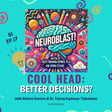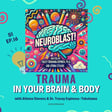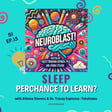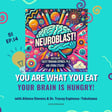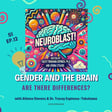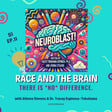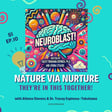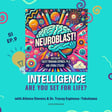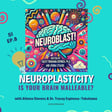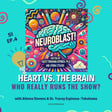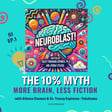Become a Creator today!Start creating today - Share your story with the world!
Start for free
00:00:00
00:00:01

Left Brain, Right Brain: Are Your Skills Really Only in One Hemisphere?
This episode debunks the myth that people are either “left-brained” or “right-brained.” Neuroscience reveals that skills like creativity and logic are distributed across interconnected brain networks. Believing in hemisphere dominance can limit potential. The brain functions as a whole, enabling everyone to develop diverse abilities through integrated processing.
Original music by: Julian Starr
Recommended
Transcript
Introduction to Brain Hemisphere Myth
00:00:00
Speaker
Fellow human beings, get ready! This No Blast!
00:00:22
Speaker
Today we're tackling a great myth that just won't quit, and we'll give you Visited its sibling before, but we are back and talking about those freaking hemispheres.
00:00:37
Speaker
The idea that skills are locked into certain parts of your brain. Not just you are either left brain or right brain, but we somehow pinpoint what part of the brain is working.
00:00:54
Speaker
So
Meet the Hosts: Athena & Tracy
00:00:55
Speaker
I am your host. actor, writer, and I can finally say student at the Harvard Extension School, Athena Stevens, and yeah we are here with... Hi, I'm Tracy Takahama-Spinoza. I'm an instructor at the Harvard Extension School in the summer school, and I'm also an international educational consultant.
00:01:22
Speaker
And I am so happy that I have finally earned him my way into the... Harvard Extension School. Congratulations.
00:01:34
Speaker
Well deserved. Thank you. And I am specializing in neuropsychology. and So long live neuropsychology. Long live neuroblast. for the love
Misconceptions from Phrenology
00:01:50
Speaker
of all of our brains, let's get rid of this ridiculous phrenology, are we?
00:02:01
Speaker
I think you're absolutely right. It's about time. This has been around forever. And so you talk about phrenology back in the 1800s, but what spun out of that and what actually, we actually created this um by giving people, you know, Nobel Prizes in physiology when they were talking about the different functions of the different hemispheres. And that sent everybody off into creating these you know these drawings of brains that are on one side, they're beautiful and colorful and creative. And on the other side, they're boxied out, like you know very logical and orderly and office-like.
00:02:35
Speaker
people just sort of thought that was the way the brain worked and for the longest time until our technology got better. So yeah, this myth has been around for a long time. People continue to believe it. It's an easy way to categorize people. Oh, you're right-brained or left-brained or...
00:02:50
Speaker
You know, who you think so right brained or whatever it is, you know, or you are so, you know, square and always just thinking so left brain. We have these kinds of generalizations that exist, but um it's so much more complicated than just, you know, separating hemispheres.
00:03:07
Speaker
And there's nothing you do, nothing you do that occurs in just one hemisphere of the brain. I remember even my uncle, who is a doctor, as in like a medical doctor, used to say, probably still says to my aunt, you could have a stroke on the right side of your brain and no one would know because you're so creative. I think it was the right side.
00:03:33
Speaker
Maybe was the left side. yeah wrong. It's not very often I get to call my uncle wrong, but I'm doing it today.
00:03:44
Speaker
You're right. and Because it's based off of, and as a medical doctor, he probably had the experience of having patients who would have strokes, and then they would have some kind of a ability loss, typically speech, and they would presume, because we've known about Broca's area and Wernicke's area for since the late the eighteen hundred And in that, we believe that that is where language um Little did we know that there's all these really intricate networks, and those are definitely important parts of your brain for language, but that we call them now um things like hubs or nodes. Those are key hubs or key nodes through which signals pass, but that's not where.
00:04:25
Speaker
languages But as a medical doctor, your uncle probably saw somebody get a stroke and then they were unable to speak and then they do an fMRI and they'd say, okay, yes, definitely.
00:04:36
Speaker
It's in the left hemisphere languages in the left hemisphere. So it's sort of by these deficits that we would make presumptions about where skill sets are. But that was, and so that was the beginning and it's, you know, intelligent speculation, but definitely that's not the whole story. And with better and better technology, we're seeing more and more parts of the brain involved in all kinds of different skillsets.
Cognition and Brain Networks
00:05:00
Speaker
So cognition is not just that we box out language in one space, you know, math in another space, artistic ability in another space.
00:05:08
Speaker
We now talk about networks. always talk about network systems throughout the hemispheres that cross the hemispheres. And here, let me just back up in just a second because you've touched on it, but here's a myth that you i can blow your mind. um
00:05:27
Speaker
You can get a Nobel Prize. for the wrong thing. You can get enough of that be wrong. that is the moving target is science. And it hasn't just happened once.
00:05:46
Speaker
Oh no. happened many times. The really time za idea of that but one of many of ideas that have really kind of the bubble of Nobel Prize. So let's talk about dynamic network system that is brain.
00:06:13
Speaker
day that to work its that is the brain Yeah. And the
The Connectome Project
00:06:21
Speaker
reason we can say this now is, and it's very, very young, young, young technology, starting around 2007, 2008, and actually getting, I believe, officially launched around 2010 or 11, the Connectome the connectum project ah was started in which you actually took multiple neuroimaging techniques and overlay them in similar populations to see exactly how networks were formed. So if we back up a bit and think about how do you know about the brain,
00:06:51
Speaker
Neuroimaging has really advanced quite a lot over the past 50 years. And we used to, and probably one of the oldest techniques, well, we still do autopsies.
00:07:01
Speaker
But what we've come to know over time is that you can measure brain activity, like when the brain is thinking or doing things, in um maybe four basic ways, electrically, chemically,
00:07:14
Speaker
structurally and sort of related to the chemically, but not really, is measuring the most popular common way is blood flow. So these bold signals, how how oxygenation occurs in the brain where parts of your brain are being, um where oxygen is being directed to when you're active. And so in measuring these kinds of things,
00:07:35
Speaker
you can piece together some ideas and and little pieces about what signals are being sent and where. Now, what's so cool about the connectome is you can combine all of these things. Instead of just having a single study that's looking at an electrical blip on the radar at one point or the chemical release at another point, what you can do is combine these things to actually piece together what is the real neural network involved in a kid's you know, understanding one plus one is two.
00:08:05
Speaker
You can actually take tons of studies, hundreds of studies of seven-year-olds doing the same problem, and then you can path what would be a typical pathway based on all those studies together. And that has changed our understanding about how the brain works.
00:08:23
Speaker
understands the world, how the brain processes and anda has cognition. um All of these things have now become much more detailed thanks to the Connectome Project. And if you go to the Human Connectome Project, I think it's.com or.org, you'll see that um the hundreds of studies that are being done right now and the money that's being put into this, all of their resources are actually online and people can see it and actually use the data because the whole idea is to create more connectome images, those are those beautiful, colorful, rainbow colored, you know, swirly, spider webby things that you can see online when you do brain scans and you put connectome.
00:09:01
Speaker
You'll see these beautiful networks. And all of them show that every single thing that is done, any single activity, any anything that you ask the brain to do is crossing hemispheres and jumping around to multiple different spaces.
00:09:16
Speaker
And now we're finally getting the technology to understand where those signals begin, where they end, you know what are the key hubs they pass through. So it wasn't wrong. Your uncle wasn't wrong about Roka's area because you'll still see when they're processing language, the electrical signal will pass through multiple times in Bokozhiro, which meant it was the strongest signal. so that would mean, yes, it's a key hub for language, but that's not where language is.
00:09:42
Speaker
It's all over the brain through all these networks. So, first of all, if you've not seen these connect don't today, they are, woo, woo, fun. They're beautiful. They're beautiful. I mean, forget any double of the infographic about, are you right brain and left brain? These are gorgeous.
00:10:02
Speaker
um there in the like But are they the same person to person? Is there similarities? We haven't even touched on neurodiversity at all in any of these episodes.
00:10:19
Speaker
Are they consistently the same or is it or what? Well,
Individual Brain Pathways
00:10:26
Speaker
that's what's so fascinating but about, um if you look at the connectome and there it's describing how whatever seven-year-olds do addition, what's fascinating is that that is probably based off of dozens, if not hundreds of kids doing that.
00:10:42
Speaker
And, And it may represent not even one of them because it's the average. It's an average thing. So this is why neuroimaging is such a kick like that because it basically you can say, you know oh my gosh, this is where language or math or whatever seems to, these are the networks related to it.
00:10:59
Speaker
But it's all based on accumulation of data that is then averaged. And so what you're seeing is not what your brain would really look like. You're seeing is what is average for that age group, for that particular activity within those parameters. And so um this is why you know people say, oh, yeah i'm I'm afraid of those neuroimaging things. They can really read your thoughts.
00:11:24
Speaker
No, they can't. They're just looking at electrical chemical signals or structural signal signal signals or oxygenation, but they're not um measuring your thoughts. It's humans.
00:11:35
Speaker
As we're saying, we put out a task and then we're trying to measure whether or not we can see that now visibly in the brain. That's what we're looking at in the Connectome Project. And so um it is what is average. It is not what your brain is actually doing. Your brain probably has some slight deviation.
00:11:50
Speaker
It's very much like metaphorically, if you talk about a face, you know, yeah we both have, you and I, we have two eyes and we have one nose and we have one mouth and we have two ears and But we don't look identical.
00:12:03
Speaker
So the places, the pieces are typically more or less the same. But there's all these variations on how people people's faces look. So that's very similar to your brains. And all of those subtle changes are due to our individualized um past experiences that actually change those networks in some way.
00:12:22
Speaker
Okay, so we were wrong. The Nobel Prize winner was wrong. The funny thing about Nobel Prize winners is 1910, you don't even remember their name. but so industry would be terrible!
00:12:40
Speaker
They were wrong, okay. But what does it matter? Like, if all of this create harm, what is the harm of this one?
Impact of the Myth on Potential
00:12:52
Speaker
The big harm with all neuromists is that they do harm because they just limit your potential. And one of the worst things I've ever seen visiting an international school, I had one kid and on her little fifth grade iPad, she had a sticker and the sticker had this brain cut in half with these colorful images on one side and these really boxy organized logical things on the other.
00:13:19
Speaker
And I said, ah well what's going on here? And she said, well, you know, i was born, you know, just so creative. But my mom says I have to learn to become more balanced. So I have to, this is to remind myself that I really need to dedicate myself more to being logical because I'm naturally creative, but I need to become more, you know, ah firm and logical and get better grades in math, you know, if I'm ever going to be anything in the world. And I was thinking,
00:13:47
Speaker
How twisted is that? Okay, that's it's great that we want kids to grow up more holistically with better understandings and and and the ability to both be scientific-minded as well as artistic.
00:13:57
Speaker
Those goals are good, but this little girl was already limiting herself. She'd already believed, well, I'm naturally this way, but I need to work on this other way. Well, the truth of the matter is we all have a little bit of everything, and we all need to work really hard to shore up the pieces that that might not be working. But the big idea is to actually you know, put that out there and try to understand that we can all become better. We can all become more creative, but creativity. oof We want to look at creativity in the Connectome Project.
00:14:29
Speaker
Wow. Talk about networks that are all over the place. Those definitely cross all hemispheres of the brain. Just one last thing about the the unnamed person, which is actually Dr. Sperry, who got the Nobel Prize.
00:14:43
Speaker
What was so fascinating is that since his work, Many other researchers have pointed to other kinds of case studies of people who've lost entire hemispheres or who had them removed, for example, because of epi early early epi epilepsy or they were born without a hemisphere.
00:15:02
Speaker
who actually grew up to be pretty normal. And so um this is the story of Nico, kid with half a brain that Mary Helen Mordenia Yang wrote about. And Antonio Damasio also documented other cases in which they show that people who...
00:15:19
Speaker
have lost entire hemispheres can still learn to function normally, which she shows you that there's this kind of redundancy in your entire body. Anything you have two of, including two hemispheres of the brain, anything two of, you can live with just one, which is pretty interesting.
00:15:36
Speaker
But the abilities of different sides were taken over. So what we thought was language in only one hemisphere could actually spread over the other hemispheres. So we know that there's this networking system that is actually based on a redundant system in the brain in which we can have losses, but then still shore up new networks that allow us to have those skill sets, which is absolutely amazing. I mean, just an incredible neurophysiological feat.
00:16:04
Speaker
I remember Ben Carson, Dr. Ben Carson, back in the 90s when he was a neurosurgeon doing a lecture that my mom sat me down in front of PBS to watch.
00:16:18
Speaker
And Dr. Carson said that someone asked him where he was, specifically where knock-knock jokes were, which is really hard to say. That takes the full brain to say that.
00:16:33
Speaker
oh And he told a story about one child that he was preparing
00:16:44
Speaker
to do
Brain Adaptability in Hemispherectomies
00:16:45
Speaker
a... What is it called? Remove one side of the brain. think go do right henis for askingka me I think I think it's that. I'm not sure. Tracy and...
00:16:56
Speaker
and ah being in a gu i a google
00:17:05
Speaker
good p I'm trying to see cerebral hemispheres, hemispheres, hemispheres, hemispheric, hemispheric, no. It's not hemispheroscopy that I said because that does not even exist.
00:17:18
Speaker
Let's see. Yeah.
00:17:22
Speaker
Oh, it is. It's there's another way to put it. Hemispherotomy. Sorry.
00:17:35
Speaker
Hemispirectomy. Hemispirectomy. Yeah, that's a hard one to say. yeah That's just a little bit of a thing. Hysterectomy. Hysterectomy, I know. was going to say it's definitely not that. Try again.
00:17:53
Speaker
So Dr. Big Cousin was saying that he was preparing to do a left hemispirectomy. on a pediatric patient and just before the patient went under, ah the child said, will I still be able to tell knock-knock jokes?
00:18:17
Speaker
And this was in the 90s and Dr. Carson said, I don't know. And the child woke up after the surgery and was able to tell a knock-knock joke. And then few years later,
00:18:33
Speaker
Another child went in having to have the opposite MSDL removed had the same good concern. and Carson again said, we don't know.
00:18:49
Speaker
we still learning all of that. And again the child woke up after the surgery and was able to tell Mac, not just same day,
00:19:00
Speaker
ah ed so Ben Carson's conclusion is, I don't know where the economic adults live in Liberian, but I can't get rid of them, apparently.
00:19:13
Speaker
and So that is, again, anything you have to hope you can live without one. I would argue that we can all live without that, not that.
00:19:30
Speaker
That's wonderful. But that does get to the really, really complex nature of cognition. You know, how do you think about things and especially humor and jokes and all the rest of that.
00:19:42
Speaker
And what we're now seeing is if you broke this down and people doing neural studies to try to figure out, well, how How are jokes understood? So how is humor understood in the brain?
00:19:52
Speaker
You get all these complex networks looking at, for example, semantic memory. Sometimes you have plays on words, right? So what does your lexical retrieval look like? So that processing is one thing.
00:20:03
Speaker
Another thing has to do with prosody or intonation, which is a totally different network, right, that has to be triggered. But then humor itself, you know, based on your prior experiences, do you consider something funny or not, right?
00:20:15
Speaker
But you'll see all of these things and more, dozens of networks just crisscrossing in order to get that knock-knock joke across. And so that's probably why and he was unable to answer that question to date. But I think it's a fascinating one because it tells us about the complexity of just every single thought we have is all over the place in our brain. It's not just one little spot, which is we got rid of... um In a mythical podcast some time ago about localizationalism, where things in your brain are in one little spot, they're definitely not.
Strengthening Skills through Rehearsal
00:20:47
Speaker
They're in networks throughout the brain.
00:20:49
Speaker
How do we strengthen these networks? How do we what? Strengthen? Yeah. Strengthening these networks is based on rehearsal, basically. So familiarity, repetition, and practice. That's basically how you become ah fluent in things. And um there's an old idea that is really getting a lot of traction now in modern neurosciences, reviewing Hebbian synapses. Donald Hebb had this idea that the neurons that fire together wire together, or his assistant too is attributed to actually saying that, but the neurons that fire together wire together, which means they become stronger. So the more times you have the same kind of stimulation, those networks are fired and those that firing strengthens the network, which makes them faster
00:21:36
Speaker
when it comes to retrieval. And so the more you rehearse something, the easier it becomes to pull it back. So for example, you just finished um your last qualifying course at Harvard, which has to do with negotiation, and and it was all based on simulation.
00:21:49
Speaker
The more you rehearse that one simulation or various simulations, the less you have to stop and think about it and go into this analysis paralysis of all these variables because you have rehearsed those networks for taking into consideration, you know, X, Y, and Z over and over and over again, it becomes familiar. So it's lower cognitive load and it's also a faster neural pathway so that you can rehearse it faster. So those neural networks are strengthened by rehearsal.
00:22:16
Speaker
And in that way, I do have to say that as an actor that is in rehearsal a lot, when... she is working. It is amazing, even if someone with a brain injury, how simply rehearsing the same hour and a half over and over settles my nervous system so that when the time of opening night comes, it is easy.
00:22:45
Speaker
That's exactly it You don't have to spend energy. You don't have to spend the energy trying to figure out where is that? Where is that pathway I need to follow? Because you've rehearsed it so much, this is what's called myelination. There's ah there's a myelin sheath that goes over the synaptic routes that is sped up. The electrical signal goes much faster through there when it's been built up. And so and that comes with rehearsal. So you're absolutely right. there's a There's a physical, not just psychological aspect to getting that those lines down before you go on stage.
00:23:15
Speaker
It actually gives you the confidence that, well, it's there. It's there. I just can retrieve it on call very easily. And that comes with rehearsal. All right. So we heard, we heard, we heard.
00:23:29
Speaker
Take the practice test, you know, if you have ah stressful negotiation coming up. Rehears are going to might go in your brain. Don't not think about it. That's the worst thing you can do.
00:23:46
Speaker
And don't fire together, water together. Tracy, I'm so thankful that I could do fire with you. LAUGHTER
00:23:59
Speaker
I think that that's a great metaphorical analysis of looking at how we actually are running this entire podcast, isn't it?
00:24:11
Speaker
Oh, that's wonderful. I
Modern Neuroscience Insights
00:24:14
Speaker
think we should, we let's remind let's remind the listeners that this huge, huge idea that's come out of this, and it's really only consolidated in the past 15 years, is that we used to think a lot of things about the brain. We used to think there was this piece of your brain dedicated to one thing or another, and you were born with it or not.
00:24:32
Speaker
We used to think and you know that ah brain functions were actually just the simplistic thing and you either had it or you didn't. And now we know all of this complex thinking is built up of these very intricate networks that have to do with different kinds of rehearsal and practice and that we learn throughout the lifespan.
00:24:52
Speaker
And these beautiful connectomes, these beautiful networks in our brains are just flourishing and getting bigger and more beautiful with every single bit of rehearsal. So contact with new people, listening to new information, growing and with the world around you is going to strengthen those networks. and so um I would just, you know, hopefully our listeners are are tuning into that biggest idea is that your brain is ever changing and you're in control of that. You know, you just go out and learn something today and you will continue to strengthen those networks.
00:25:22
Speaker
All right. Well, strengthening this network. oh the Please subscribe to Neuroblast and tell your friends about We love what we do and we would like to keep going, so do like, subscribe, and share.
00:25:41
Speaker
Remember, Neuroblast is produced by agents' productions with music it by Julian Starr. Special thanks to the Harvard Extension School who actually allowed you Tracy and I to be in one room together for an entire summer.
00:26:02
Speaker
That's a miracle in and of itself, and that's what this project was born out of. And you aren't just using 10% of your brain.
00:26:13
Speaker
You aren't just left brain or right brain. You are your whole brain. And that's the entire thing it takes to be you and to be our brain.
00:26:25
Speaker
we'll see you next
00:26:37
Speaker
Bye.

